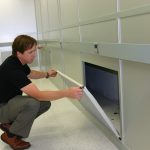 Pharmaceutical industry experts predict an evolution in cleanroom cleaning between now and 2020. They speculate that materials, techniques, and even guidelines used to clean will all look different. However, the current state of the industry suggests that cleanroom workers are not even up to par in cleaning for today’s standards. This matter urgently needs to be addressed. Barbara and Ed Kanegsberg tackled this issue in their Controlled Environments article, “2020 Pharma.”
Pharmaceutical industry experts predict an evolution in cleanroom cleaning between now and 2020. They speculate that materials, techniques, and even guidelines used to clean will all look different. However, the current state of the industry suggests that cleanroom workers are not even up to par in cleaning for today’s standards. This matter urgently needs to be addressed. Barbara and Ed Kanegsberg tackled this issue in their Controlled Environments article, “2020 Pharma.”
The Kanegsbergs call upon the expertise of Paul Pluta, Associate Professor of Biopharmaceutics, College of Pharmacy at University of Illinois, Chicago and Editor in Chief of the Journal of Validation Technology and the Journal of GXP Compliance. Pluta points out what he knows people are doing wrong the pharmaceutical industry:
• Not determining their worst case compound
• Not identifying the actual residue on the equipment
• Using uncontrolled concentration of cleaning agents in water
• Using illogical cleaning agents
• Cleaning equipment to pass validation rather than in a consistent manner
Those who are guilty of the above are going to have an extremely difficult time meeting requirements when guidelines change and more monitoring is implemented. Considering the evolution of drug resistant organisms, lax cleaning practices are not just obstacles, but great safety concerns.
So how does a company turn this around?
One important place to start is the expert and pay level of the people doing the cleaning. The article states, “‘Who cleans the floor?’ asks Pluta. ‘The lowest one on the totem pole. That should change. We have to say: ‘We will train you. We will have competent personnel do the training. We will pay you appropriately.’ That would be fantastic!’”
Proper training is not just about the proper way to clean; it is also about explaining the importance of the job. Investing in personnel, including onsite trainers, backs the idea that the cleaning responsibilities are great ones.
Another change to make immediately is to have a cleaning plan. Pluta suggests following the FDA lifecycle approach: “Lifecycle means 1) proper design and development of the cleaning process; 2) proving it works by validation; and 3) maintaining the process by periodic review of performance. By this method, deficiencies will be noted and continuous improvements should occur.”
A cleaning process should be controlled and monitored. Employees should collect data on temperature, time, concentration, and rinse water conductivity. This should all be part of the cleaning process design.
The pharmaceutical industry can look forward to some distinct and effective changes over the next six years. Companies can only move forward, however, if they are operating at the current expected standard. Failure to improve the cleaning process now will jeopardize business in the fast-approaching future.